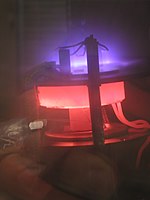
Photo from wikipedia
Abstract In this study, graphene nanoribbon (GNR) was produced through oxidative unzipping of multiwalled carbon nanotube (MWCNT) to integrate high aspect ratio features of MWCNT with a planar structure of… Click to show full abstract
Abstract In this study, graphene nanoribbon (GNR) was produced through oxidative unzipping of multiwalled carbon nanotube (MWCNT) to integrate high aspect ratio features of MWCNT with a planar structure of the graphene. Afterward, its structural effect (shape and aspect ratio) on mechanical and anti-corrosion performance of polyurethane (PU) nanocomposites was thoroughly investigated utilizing uniaxial tensile measurement and electrochemical impedance spectroscopy (EIS). The results were compared to MWCNT with tubular high aspect ratio and graphene nanoplatelet (GnP) with a planar low aspect ratio structure. PU-filler nanocomposites were produced with different nanoparticle loadings and applied to a cold rolled steel substrate for mechanical and anti-corrosion measurements. As a nanocomposite filler, MWCNT performs well in terms of mechanical properties, and GnP shows higher anti-corrosion performance. However, PU-GNR pronounces in both mechanical properties and corrosion resistance. Young’s modulus of 0.5 wt% PU-GNR nanocomposite reaches 3.52 MPa, which is around 1.6 and 1.4 times higher than the PU-GnP (2.19 MPa) and PU-MWCNT (2.52 MPa), respectively. Furthermore, PU-GNR exhibits the highest corrosion resistance of 8.45 × 105 Ω·cm2 compared to PU-GnP with 5.14 × 105 Ω·cm2 and PU-MWCNT with 4.09 × 105 Ω·cm2. The better performance of the PU-GNR nanocomposites is attributed to the planar structure, high aspect ratio, uniform dispersion and better polymer-filler interactions. They contribute to not only improve load-bearing properties of the nanocomposite but also build a tortuous pathway suppressing corrosive agents’ diffusion to the PU matrix.
Journal Title: Chemical Engineering Journal
Year Published: 2021
Link to full text (if available)
Share on Social Media: Sign Up to like & get
recommendations!